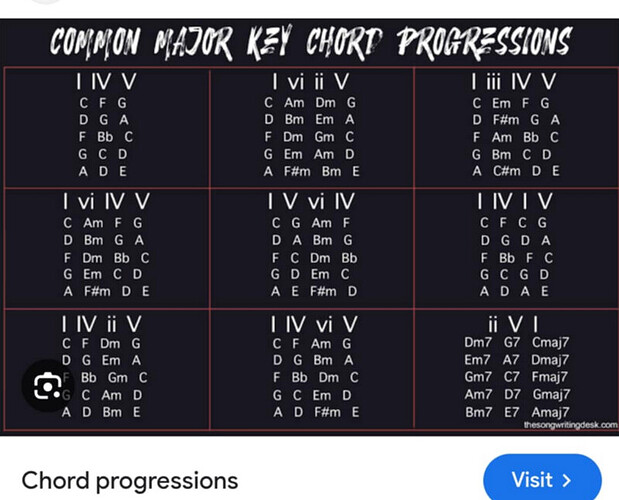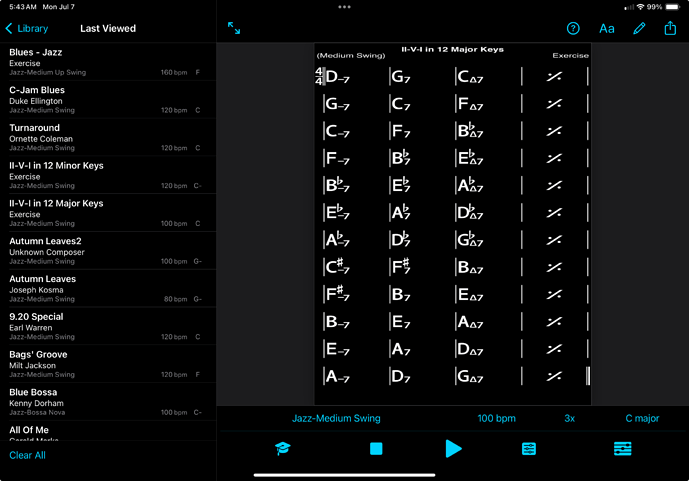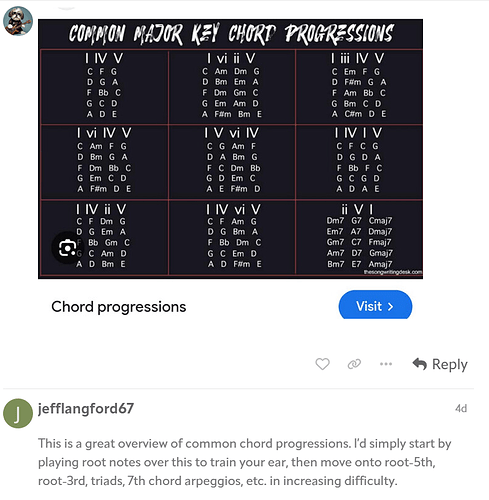Hi, can I have some advice from you on how to improve or enhance my chord progression skills? What exercises do you use daily to improve that? Thank you.
Could you expand a bit on what you mean by “chord progression skills”? Playing over established chord progressions? Or coming up with your own chord progressions?
What exercise should I practice to improve that? by doing 1,6,4,5 for all keys? Just transpose?
Hm, OK, I guess you mean “playing over a chord progression”…
I would encourage you to find suitable backing tracks and start to, literally, play “around” with them. Find out what works, get a feel for which notes that work, and which that sound off or just bluesy/funky…
But, also, on the side, look at which scales/modes would work over the chords and try to see how you can see the scales on the fretboard and get them under your fingers.
Start playing them like scales, but then play more freely and taking note of the underlying rhythm or groove.
Start easy with something like this:
Then, slowly, expand to other chord progressions (more chords, etc.)
I wouldn’t just l´play a I-vi-IV-V in all keys… that seems… boring ![]()
IReal Pro is another option, you can use what’s there or make your own chord progressions, then change the key.
@joergkutter, this one I created an example. Not sure if this is appropriate on Key of C.
Intro:
C - Em - G - Am
C - Em - G - F
Verse:
G - B - Dm - B
F - A - Dm - G
Back to Intro.
After those, I’ll transpose it to the different keys using the number system?
It’s a little tricky for me to give advice on your chord progression, not really knowing/understanding what your goal here exactly is…
Most modern popular music uses (mainly) diatonic chords, i.e., chords from the same scale.
With that in mind, you have a B chord in there, which should be B diminished to be diatonic, and you have an A chord in there, which should be an Am chord to be diatonic.
(Note: nothing/nobody forces you to use diatonic chords only, but, usually, you know right away that they work nicely together).
Sure. Personally, I find this a bit boring (without any specific reason to transpose the chord sequence, such as, e.g., to accommodate a singer’s range), but it’s a good exercise; also from a theory point of view. Since the bass is very “symmetric”, it’s much easier to transpose than, say, on a saxophone.
got it sir. for example on C, I’m going to use C major scale or Triad, for Em- E Minor scale or Triad same as well to Am, when it comes to B dim. I should also use B dim triad for that. just practicing with my own method.
Indeed!
B - D - F ![]()
thank you sir @joergkutter, probably i’m going to add some open or close voicings while doing triad. ![]()
@Samantha.Cooper not sure what the goal here is, but perhaps start with a simple I-IV-V progression, in C major, then shift that to other keys. Then try a ii-V-I in C major, then shift that to other keys. Then try a vi-ii-V-I, in C major, then shift that to other keys. This is a methodical approach to practicing playing bass over chord progressions.
You can find backing tracks on YouTube for this or use something like IReal Pro to create these (or use what’s already there).
If your goal is to create your own chord progressions, then I have no advice.
Here’s an excellent source of over 200 bass-free backing tracks, including a few with drums only. Lots of funk, with some rock, blues, reggae, disco and a couple of other genres.
JunzMusic Bass-free Backing Tracks
Here’s an example. Key and BPM in the video title. Any chord changes are indicated in the animated area at the bottom of the video.
Here’s another great YouTube channel. They have backing tracks, similar to above, but both with and without bass, if you want to try and get some ideas of what to play. Similarly, they show the key and chord progression and suggest which modes to play over the chords. They also have difficulty ratings so you don’t get frustrated trying to play over something too hard to start with.
Coolio! Thanks for sharing. Sub’d.
@jefflangford67 Thanks for this. It can be useful. is that good thing to add this on my recipe. so when I transcribe something I’m also aware all those progression. probably they may register to my ear automatically while playing them.
This is a great overview of common chord progressions. I’d simply start by playing root notes over this to train your ear, then move onto root-5th, root-3rd, triads, 7th chord arpeggios, etc. in increasing difficulty.
IReal Pro has a mode where you can enter a chord progression then tell it to advance either a half step or a whole step each run through. Very useful for something like this.
Huge +1 to that!
For this example, is it a song that actually exists?
Playing to a chord progression that is made up arbitrarily won’t be helpful.
Backing tracks will be composed to logical progressions that go to actual songs (or are generic and able to plug into a bunch of different things) so they’d be a much better tool.
newbie question if you dont mind?
i get the chord progressions, and so with the first example, youd noodle around on C for a bit, roots and fifths or whever, then when the guitarist moves to F youd do the same with whatever notes and rhythm you think sounds good.
but whats that last example all about? ok it looks like its C major but starts on D, then moves to G before landing on the C, but whats the maj7 all about? are there different notes available to you with that chord? or would you still be playing roots and fifths, triads etc? whats the difference between a normal C on all of the others, to Cmaj7 in regards to what you would actually play?
thanks
Here’s a very good explanation. They are all 4 note chords of 3 stacked thirds.
This is a super common chord progression in jazz, called a ii-V-I (here, in the key of C, this is D minor 7 to G dominant 7 to C major 7).
If you instead of triads (two thirds stacked on top of each other) stack three thirds, you will get chords called “seventh chords”, as they all consist of root-third-fifth-seventh.
Seventh chords are “just” a bit more colorful than triads. Depending on the “flavor” of the thirds (minor/major), the fifths (perfect/dimished/augmented), and the sevenths (minor/major), you get different types of seventh chords.
That is why you, in the example given, have Dmin7, G7 and Cmaj7 (the differences are explained in more detail in the link @TheMaartian provided).
As for what to play over them: you can still get a long way with roots and fifths. The only caveat here is when you encounter a half-dimished seventh chord (here, it would be Bø7), then you should use the dimished fifth instead.




